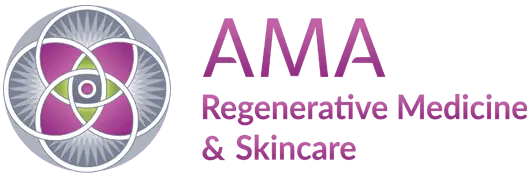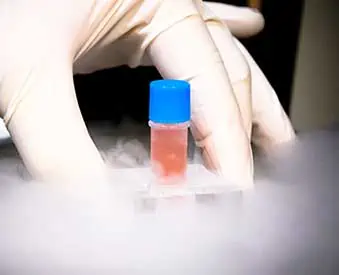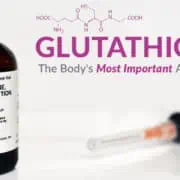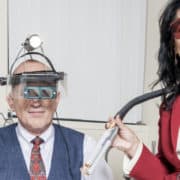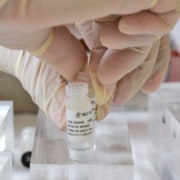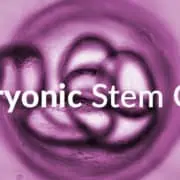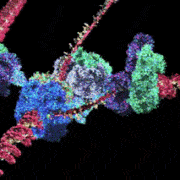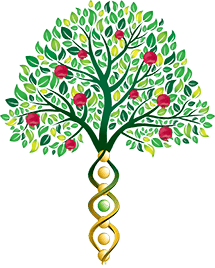The Science of Stem Cells – Part 2 – Sources and Functions
Lecture : What are stem cells? – Part 2 of 4 – Where do they come from?
(The following is a transcription of the above video)
There are three sources of stem cells.
- There are the embryonic stem cells, those stem cells that are part of a developing fetus.
- There are the placental stem cells, which are the placenta and the umbilical cord.
- All of our adult organs have stem cells in them as well.
Which stem cells are used in medicine?
1st Source – Embryonic Stem Cells
We do not use the first source of stem cells, the embryonic stem cell.
The Controversy of Embryonic Stem Cells
You may recall a few years back there was a great deal of political upheaval and controversy about the use of embryonic stem cells, why? Because when you pluck those cells out of a developing embryo, you are in fact interfering with the development of a human life.
For all of the ethical reasons this is very controversial and should be.
Embryonic Stem Cells are NOT Used in Clinical Medicine
Now, from a medical perspective, we wouldn’t use those cells in stem cell therapies anyway. Because those cells are still undifferentiated.

Embryonic stem cells are still undifferentiated and NOT used in clinical medicine
Remember, they haven’t yet decided which line they’re going to be a part of, which organ system they’re going to be a part of. They have all of those options ahead of them and you don’t know which direction they’re going to go.
If you took some of those cells out to try to cure a liver and stuck them in someone’s liver, you don’t know that they’re going to become liver cells, they could become something else.
Not a good situation, so in clinical medicine, they are not used and never were, so we can just let them go for now. Embryonic stem cells are used for research purposes but not in clinical medicine.
2nd Source – Placental Stem Cells
The second source of stem cells, the placental cells, ARE used in clinical medicine.
In fact, most of what I’m going to be talking about today are the characteristics and the use of placental stem cells.

Image of a mesenchymal stem cell.
These are called Mesenchymal Stem Cells that are extracted out of, or harvested from, umbilical cords.
NO Controversy with Placental Stem Cells
There is no controversy there at all because after the baby is born, the next delivery in fact, is the placenta and the cord and those are considered medical waste. They’re going to be incinerated and simply disposed of which is a shame because stem cells are in those tissues and they’re very valuable.
With the mother’s permission, they can be donated to science or given to a cord bank for preservation in case the mother and / or the child need those cells in the future.
Or they can be used for medications or for treatments such as we’re going to be talking about today. That’s the second source of stem cells.
3rd Source – Adult Stem Cells
The third source of stem cells are the adult stem cells. Remember, we have them in our own organs.
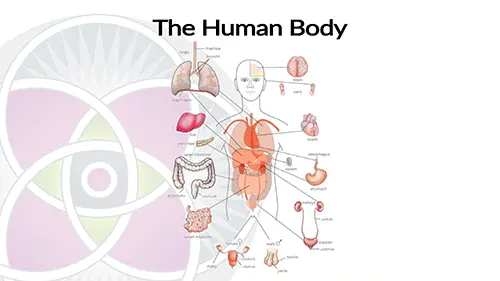
Each organ system has adult stem cells that are specifically programed and equipped to care for that organ.
Now you wouldn’t want to extract stem cells from someone’s liver. That would be painful and not very efficient.
Harvesting Adult Stem Cells
There are three places we can get stem cells out of a human body efficiently and effectively without causing too much disruption or pain.
1. Bone Marrow
You can drill into someone’s bone and extract the bone marrow, which is filled with stem cells.
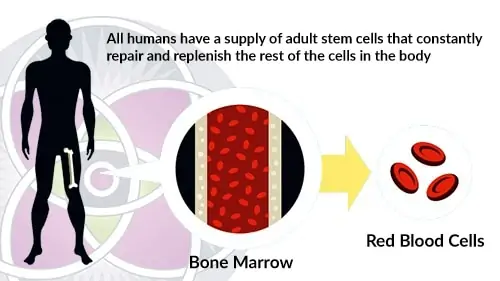
Adult stem cells can be harvested from the patient’s femur bone.
Not the most comfortable procedure I assure you, but it can be done easily.
2. Blood
You can simply remove some of the blood and extract stem cells from somebody’s blood. A very easy procedure to do.
3. Fat
There are a lot of stem cells in fat. Those stem cells happen to be dormant but there are a lot of them in there and they’re commonly used in clinical medicine.
Processing the Harvested Stem Cells
About the adult stem cells, what do you do with them after you’ve harvested them? After you’ve extracted them from your patient?
A patient comes into the office, they want for instance, a stem cell injection for their knee because they have a banged-up knee.
You take some of their fat and the first thing you have to do is clean that fat. Extract and distill out the stem cells and then you prepare them in whatever way is necessary to be re-injected or re-infused into the patient.
Concerns of Harvesting Adult Stem Cells
There are 4 major concerns when harvesting the stem cells of an adult.
1. Pain
Obviously the discomfort of the procedure.
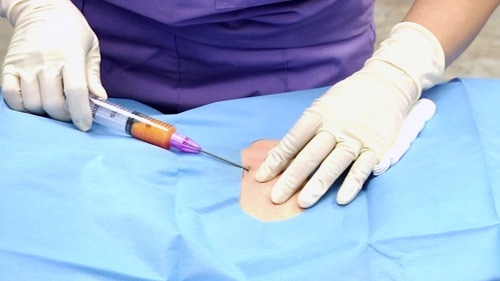
Harvesting fat from a patient’s belly. Stem cells from fat are commonly used in clinical medicine.
If you’re extracting the cells from someone’s belly, you’re going to bruise them. It’s not the most comfortable procedure, though with an anesthetic, it can be comfortable but the patient is going to bruise and there’s going to be some discomfort afterwards.
2. Infection
There’s always the possibility of causing an infection in the area from which you’ve extracted the stem cells.
3. Contamination
There’s also the issue of contamination.
During the time, in the procedure, where you are distilling the stem cells, cleansing them, preparing them. What if some contaminant got in there?
4. Age of Stem Cells
The last concern and one of the most important in my mind is the fact that these are stem cells of an adult.
Let’s say you have a 50 year old patient, well they have 50 year old stem cells in there. Those 50 year old stem cells are not nearly as potent. They do not have as much potential and vitality as the young stem cells that are extracted from umbilical cords.
Stem Cells and Age
As we age, two things happen to our stem cells. First, we lose the numbers of them.
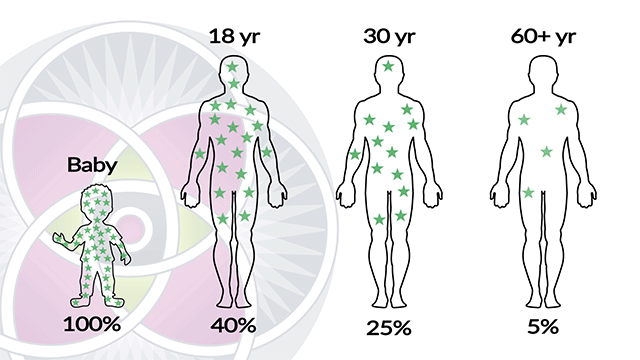
As we age, the number of stem cell we have decreases and the stem cells we do still have lose their vitality.
The Number of Stem Cells Decreases
In fact, from a brand new baby to 18 years old, you lose about 60 percent of your stem cells.
From 18 years old to 30 years old you lose another 25 percent of them.
By the time you’re 50, 60 and 70, you’re down to around 5% of the amount of stem cells you had when you were a baby.
The Stem Cells Lose Functionality
Not only do you lose the number of stem cells in your body, but the stem cells that you do have are not nearly as potent, as functional and as eager to do the job that they’re supposed to do. They lose functionality. The adult stem cells that you extract out of a 50 year old patient who has a knee issue, are not going to be as vital as umbilical cord stem cells.
The Science
To give you a very clear example here’s the science behind it.
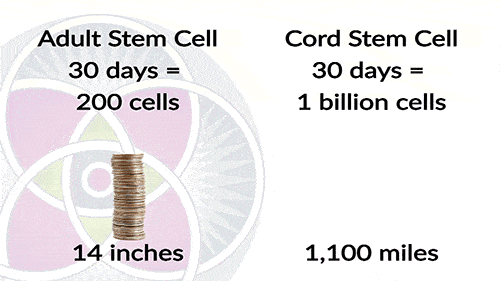
A comparison of the “potency” or functionality of adult stem cells versus mesenchymal stem cells.
If we take one of those adult stem cells from someone’s fat and we put it in a petri dish and nourish it with all the things that it likes to eat and be happy. In 30 days that one adult stem cell is going to become 200 cells. Not bad, 200 out of one.
Now, take that same umbilical cord mesenchymal stem cell put in the same petri dish with the same nutrients. In one-months time it will become over a billion cells. Two hundred to a billion.
That’s the difference between the vitality of an older persons stem cell versus a young nascent cell from an umbilical cord whose entire life and vitality are still ahead of it.
A good way to imagine this since we talk about billions all the time and we kind of don’t really know how much a billion is. If you took 200 quarters, like the 200 cells from an adult stem cell and stack them up maybe 14 inches tall.
If you took a billion quarters and stacked them up, they’d be over a thousand miles tall.
A thousand miles versus 14 inches, this is a huge difference in their vitality, their potential and their capacity to regenerate and bring new life to a patient.
How Stem Cells Function
The umbilical cord mesenchymal stem cell.
How does it work? What are its characteristics? How does it function?
1. Homing to Damaged Tissue
When you infuse mesenchymal stem cells into someone’s body, studies show that those cells will home to the damaged tissue. We know this because you can put markers on those cells.
If someone has a damaged heart and you infuse those cells into their body, studies have shown that you can see them migrating directly to the damaged tissue.
It’s brilliant, it’s mysterious how they do this. It’s part of the mystery, magic and the miracle of our physiology.
2. Attach to Micro-capillaries
When the mesenchymal stem cells get to their destination, these stem cells latch on to the micro-vasculature, the tiny little capillaries of that organ.
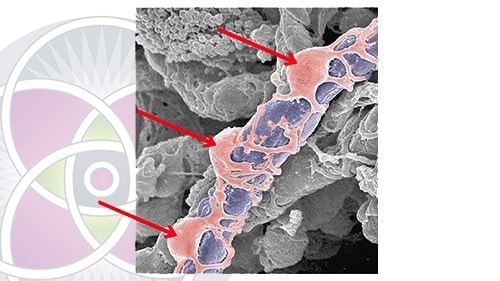
Image of mesenchymal stem cells (in red) attaching themselves to the micro-vasculature (in blue).
When the stem cells are attached there, there is one thing they don’t do and one thing that they do, do.
A. Mesenchymal Stem Cells Do not Become Organ Tissue
What they don’t do is become that organ tissue.
Along the way earlier I said how stem cells would duplicate or replicate themselves and then the other cell will become the tissue that needed to be replaced. These mesenchymal stem cells from the umbilical cord do not do that. It’s called engrafting.
They do latch on to the little tiny capillaries in that organ but they don’t become that organ tissue.
B. Mesenchymal Stem Cells Release Messaging Molecules:
These mesenchymal stem cells release this magic soup of signaling messaging molecules.
Remember those little vesicles that were on the surface of the cell?

The vesicles on the surface of the mesenchymal stem cell release a soup of messaging molecules that cause massive regeneration of tissue.
Those little bubbles pop and this soup comes out that is filled with all these incredible cytokines, which cause massive regeneration of the tissue.
In fact, one of the things that this soup does is stimulate the native stem cells in that organ to do what they used to do when you were a baby. Studies show that this massive regeneration happens because of what the mesenchymal stem cells release.
Discovery of Mesenchymal Stem Cells
Dr. Arnold Caplan is the brilliant scientist who discovered these mesenchymal stem cells in umbilical cords. He named them of course, to define them as mesenchymal stem cells (MSC).

Dr. Arnold Caplan discovered the mesenchymal stem cell.
This magic soup that they release is such a powerful element of why these cells are so powerful in our physiology, that he is playing around with the idea of changing MSC from Mesenchymal Stem Cells to Medicinal Signaling Cells, also MSC.
Up next …
About the Authors
[simple-author-box]
References
- Anzalone R, Opatrilova R, Kruzliak P, Gerbino A and La Rocca G. Mesenchymal Stromal Cells From Wharton’s Jelly (WJ-MSCs): Coupling Their Hidden Differentiative Program to Their Frank Immunomodulatory Phenotype. 2018;20:271-279.
- Vangsness CT Jr, Sternberg H, Harris L. Umbilical Cord Tissue Offers the Greatest Number of Harvestable Mesenchymal Stem Cells for Research and Clinical Application: A Literature Review of Different Harvest Sites. 2015 Sep;31(9):1836-43.
- Watson N, Divers R, Kedar R, Mehindru A, Mehindru A, Borlongan M, Borlongan C. Discarded Wharton’s Jelly of the Human Umbilical Cord: A Viable Source for Mesenchymal Stem Cells. 2015 Jan;17(1):18–24.
- Kalaszczynska I, Ferdyn K. Wharton’s Jelly Derived Mesenchymal Stem Cells: Future of Regenerative Medicine? Recent Findings and Clinical Significance. 2015, Article ID 430847, 11 pages.
- Davies J, Walker J, Keating A. Concise Review: Wharton’s Jelly: The Rich, but Enigmatic, Source of Mesenchymal Stromal Cells. 2017 Jul;6(7):1620–1630.
- Weiss M, Troyer D. Stem Cells in the Umbilical Cord. 2006;2(2):155–162.
- Erices A, Conget P, Minguell J. Mesenchymal Progenitor Cells in Human Umbilical Cord Blood. 2000 Apr;109(1):235-42.
- Shawki S, Gaafar T, Erfan H, El Khateeb E, El Sheikhah A, El Hawary R. Immunomodulatory Effects of Umbilical Cord‐Derived Mesenchymal Stem Cells. 2015 Jun;59(6):348-56.
- Arutyunyan I, Elchaninov A, Makarov A, Fatkhudinov T. Umbilical Cord as Prospective Source for Mesenchymal Stem Cell-Based Therapy. 2016;2016:6901286.
- SubramanianA, Fong C, Biswas A, Bongso A. Comparative Characterization of Cells from the Various Compartments of the Human Umbilical Cord Shows that the Wharton’s Jelly Compartment Provides the Best Source of Clinically Utilizable Mesenchymal Stem Cells. 2015 Jun;10(6):e0127992
- Ilic D, Polak JM. Stem Cells in Regenerative Medicine: Introduction. 2011;98:117-26.
- Sanchez-Ramos J. Stem Cells from Umbilical Cord Blood. 2006 Nov;24(5):358-69.
- Low CB, Liou YC, Tang BL. Neural Differentiation and Potential use of Stem Cells from the Human Umbilical Cord for Central Nervous System Transplantation Therapy. 2008 Jun;86(8):1670-9.
- Herranz AS, Gonzalo-Gobernado R, Reimers D, Asensio MJ, Rodríguez-Serrano M, Bazán E. Applications of Human Umbilical Cord Blood Cells in Central Nervous System Regeneration. 2010 Mar;5(1):17-22.
- Zarrabi M, Mousavi SH, Abroun S, Sadeghi B. Potential uses for Cord Blood Mesenchymal Stem Cells. 2014 Winter;15(4):274-81.
- Kabataş S, Civelek E, İnci Ç, Yalçınkaya EY, Günel G, Kır G, Albayrak E, Öztürk E, Adaş G, Karaöz E. Wharton’s Jelly-Derived Mesenchymal Stem Cell Transplantation in a Patient with Hypoxic-Ischemic Encephalopathy: A Pilot Study. 2018 Oct;27(10):1425-1433.
- Sadlik B, Jaroslawski G, Puszkarz M, Blasiak A, Oldak T, Gladysz D, Whyte G. Cartilage Repair in the Knee Using Umbilical Cord Wharton’s Jelly–Derived Mesenchymal Stem Cells Embedded Onto Collagen Scaffolding and Implanted Under Dry Arthroscopy. 2018 Jan;7(1):e57–e63.
- Kim DW, Staples M, Shinozuka K, Pantcheva P, Kang SD, Borlongan CV. Wharton’s Jelly-Derived Mesenchymal Stem Cells: Phenotypic Characterization and Optimizing Their Therapeutic Potential for Clinical Applications. 2013 May 31;14(6):11692-712.
- Nagamura-Inoue T, He H. Umbilical Cord-Derived Mesenchymal Stem Cells: Their Advantages and Potential Clinical Utility. 2014 Apr 26;6(2):195–202.
- Kalaszczynska I and Ferdyn K. Wharton’s Jelly Derived Mesenchymal Stem Cells: Future of Regenerative Medicine? Recent Findings and Clinical Significance. 2014 Dec.
